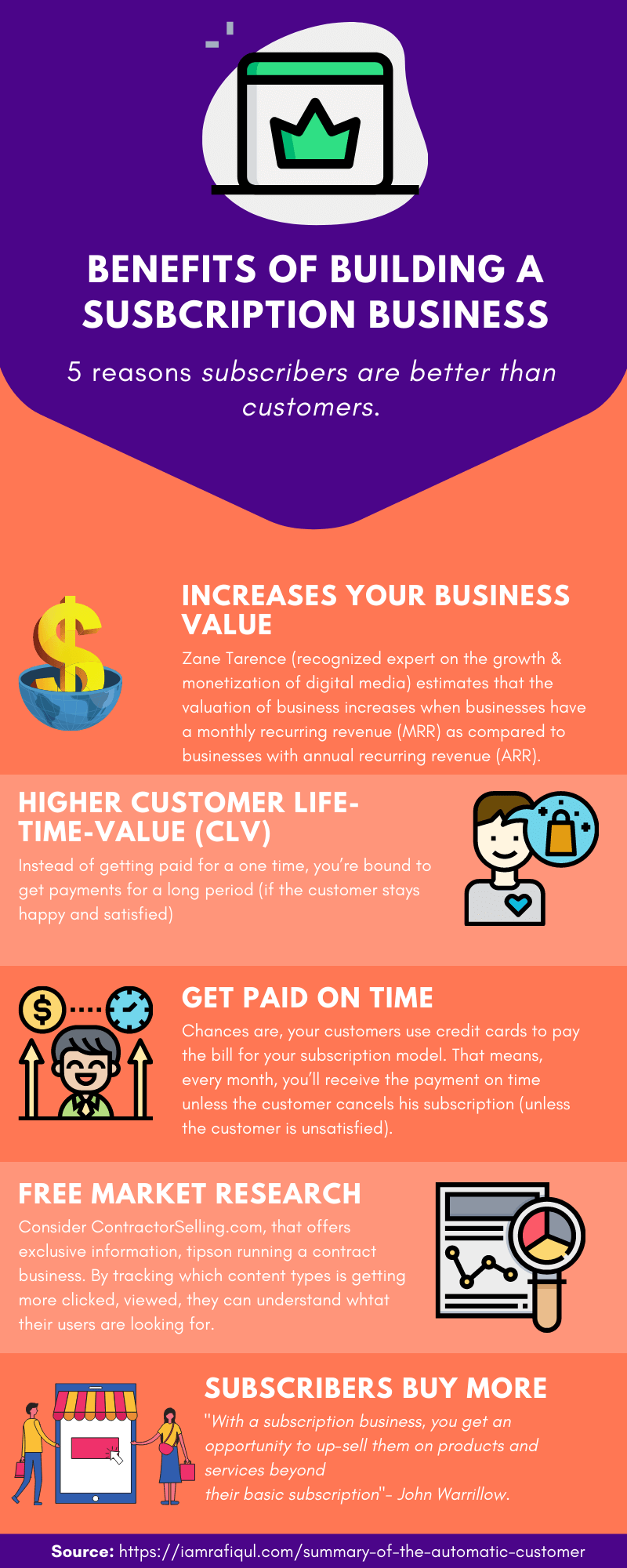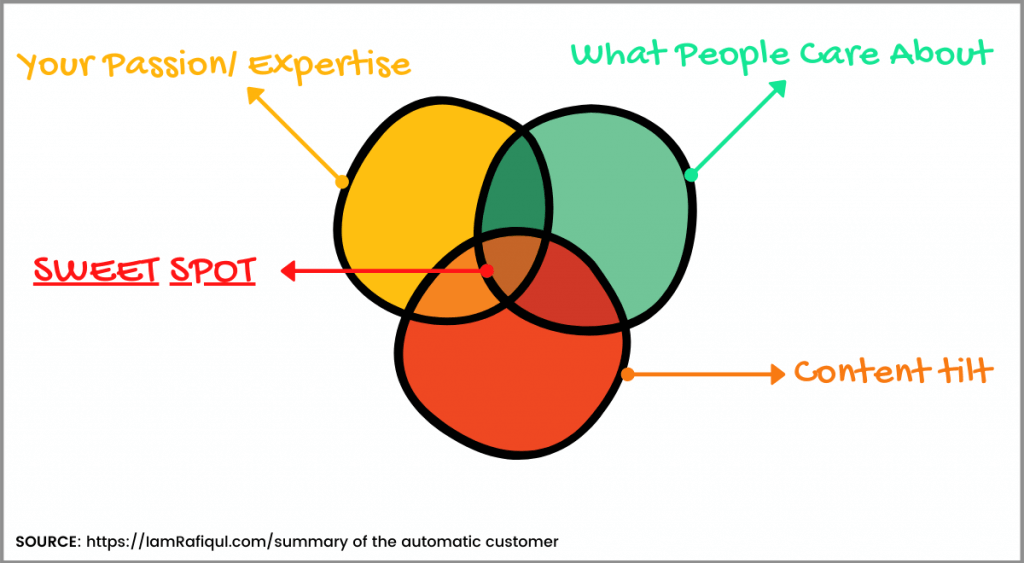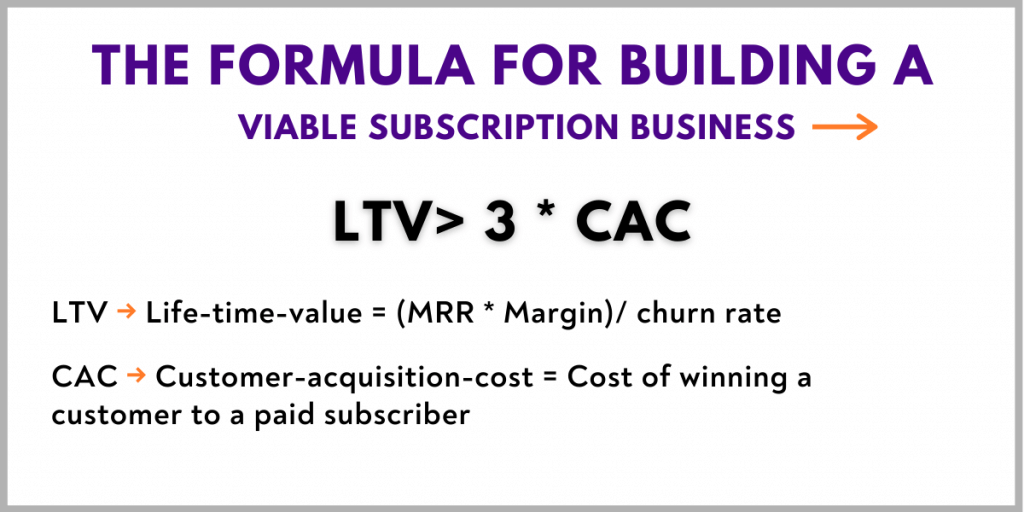From amazon prime to Netflix, you’ll notice the rise of the subscription-based business model for a reason.
No, you don’t need a million-dollar company to get started with this business model. In fact, there are tons of examples (which I’ll share in this article) where a subscription business is built with a small, targeted audience.
Before you move forward to the article, here are few things to know:
- This is a summary of the book, The Automatic Customers.
- But as a content marketing enthusiast, I’ve tried to relate many principles discussed in the book with content marketing and audience building.
- Added a few quotes and references outside of the book to make it a must-read for every content marketer.
Let’s get started →
💡 Benefits of Subscription business model

Let’s first understand why the Subscription model is the right fit for your business or startup.
1. Increases your business value
Having a subscription model can eventually increase your overall business value by far.
Zane Tarence (recognized expert on the growth & monetization of digital media) estimates that the valuation of business increases when businesses have a monthly recurring revenue (MRR) as compared to businesses with annual recurring revenue (ARR).
For example, an average small business with $500,000 or less in sales gets an offer of 2.6 times of pre-tax profit.
[If the pre-tax profit is $X, then on average that business will get a buying offer at 2.6 times of $X (= $2.6*X)]
When it comes to a business with a monthly-recurring -revenue, it easily gets 3.7 times the pre-tax profit.
[Here, the business will get a buying offer of 3.7 times of $X (= $3.7*X)]
The difference is clear.
Even if you have a plan to sell your business in the future, this model can skyrocket your business valuation.
2. Higher customer life-time-value (LTV)
Instead of getting paid for a one time, you’re bound to get payments for a long period (if the customer stays happy and satisfied)
Let’s look at a real-life example:
Usually, a traditional flower store faces many challenges like:
- They need to identify the demand for flowers each month, or each week or even daily. Overestimation will cause waste of flowers, and under-estimation of the demand will results in less revenue (hence less profit)
- Every month they need to find customers from scratch. Also, chances are many customers will only come to these stores only once in a lifetime.
- A typical flower store needs to rent a physical store (costly) to showcase the products (flowers, in this case)
Now, let’s compare the store with a subscription business created by H.Bloom that sells the same product (fresh flowers) to the same audience (restaurants, Spa, Hotels).
H.Bloom sells flowers on a monthly, weekly, and even bi-weekly delivery instead of one-time selling.
Now the competitive advantages that they get:
- They don’t need to find customers scratch (at least they’ll have existing customers with a certain churn rate)
- No need of physically present in the store
- Builds a long-term business relationship because of the subscription program
There are also few drawbacks of this model that I’ll discuss later in the article.
In fact, your paid subscribers are the ones who’ll pay for your other products or services as they are already in a business relationship with your brand- Trust leads to a transaction.
💡 Get actionable content marketing and SEO insights, latest updates, lots of free resources, by emails | Once a week, for free.
3. Get paid on time
Chances are, your customers use credit cards to pay the bill for your subscription model. That means, every month, you’ll receive the payment on time unless the customer cancels his subscription (unless the customer is unsatisfied).
In the case of traditional business, it is sometimes a little too hard to expect payment on the right day.
Now, you know some of the most important benefits of having a subscription model. No, you don’t need to completely turn off your existing business model and start with this one.
Instead, you may start a subscription model complementing your main business.
And, knowing some of the effective types of subscription models will help you strategize and plan your model.
Let’s explore →
💡 Types of the subscription model
Membership sites
Wall street journal is one of the examples that have turned this model into a successful business with thousands of paying subscribers.
The easiest way to identify whether this model can work for you is by asking the following question →
- Do I have expertise or passion for any specific topic that is worth paying for?
It could be about self-development, health tips, industry news, etc.

Most of the successful subscription business (membership sites) is built over this concept:
Expertise + what people ready to for + content tilt (that separates the content from the rest) = Membership sites
The concept of content tilt (mentioned by Joe Pulizzi) is now more important than ever before.
Shortage of information is not the issue in this digital age where everything is almost accessible for free with a few clicks. But the quality and adding different ways of presenting it to solve the pain points of users can make a difference.
Example:
In 2008, Suzane and Kathy decided to launch their first membership site called DanceStudioOwner.com that offers helpful content (classes) to teach dancing for just $1 for the first 21 days. And after that, $97 for the full year.
As Kathy was an industry leader and she wanted to scale this by working remotely. By 2010, they had around 200 active members for $97/ year.
Even after doubling the subscription rate, their subscriber base keeps growing.
The membership site model works well if you:
- Can target a very specific niche audience
- Have the resources to deliver unique, fresh, and expert insights to the subscribers on a regular basis.
- You have other relevant products to sell /offer
Library model
The library model of the subscription is like a library with a collection of thousands of books from different categories.
Instead of targeting any specific genre, category, the Library model allows you to grab whatever you want, whatever you like.
One example that you’ll resonate with most:
“Unlimited movies, TV, Shows and More.”
The Netflix subscription model relies on the same principle where you can enjoy shows from thousands of web series, shows, etc.

Again, this can also be considered as the membership site as well as library model.
The challenge to face:
Creating a large pool of content itself is a great task, especially if you’re a one-man show or don’t have enough resources.
So is this only for large media companies or tech industries?
Necessarily not.
Back in 2012, Jacobo started an art library, a library of content that offers unlimited how-to classes.
Instead of creating content from scratch, Jacobo partnered with artists.
Here’s how:
Every artist who contributes video classes will get a royalty based on the number of subscribers.
So it’s a win-win situation for Jacobo and different artists as well.
By using this formula, he was able to launch his library site with 100+ hours of content.
This method not only helped Jacobo to build a content empire but also to get early subscribers because every contributor is asked to share their content with the audience.
Library subscription model works if:
- Produced content is on evergreen topics. In that way, every content will stay up-to-date for a long time.
- You can partner with influencers/ experts within your niche.
3. The private club model
Access to something exclusive or rare is the center point of a private club model. In some cases, the higher the barrier to entry to the private club, the more hype it may create.
Consider ClubHouse, which is not only an invite-only social media platform but also available exclusively for Apple users.
As a result, the percentage of increase in globe searches of ClubHouse is 7400%.
Source: Exploding Topics
[In addition to the invite-only feature and Exclusivity for Apple users, the voice chat room also contributed to this growth]
Not sure whether this model will work for you? Consider…
AdLeads is a private members-only community where helps members to network with successful marketers all around the world.
Also, they get some secret marketing tactics from world-class experts.
The privacy to access this group can be understood from its entry process.
First, sign up,
Next, an official member from the AdLeaks team will appoint a meeting with you before giving you access.
Also, there is a non-refundable fee of $49 for gold and $99 for platinum.
After all of this, you’ll get notified whether your application is approved or not.
Does it work?
Yes, even though it seems like a rare program that very few people all around the world join, the annual revenue of Adleaks is nearly $1 billion.
The private club model works well if:
- You can consider something that has high demand but low supply.
💡 The formula for building a successful subscription business
The foundation of any subscription business is dependent on three factors:
- Monthly-recurring-revenue (MRR)
- Customer lifetime value (LTV)
- Customer-acquisition-cost (CAC)
Before we dive into the formula to build a sustainable model, let’s understand these terminologies.
Monthly recurring revenue (MRR)
The total revenue of your business per month.
For example: if you sell a subscription of $1200 for a year, your MRR would be $1200/12 = $120
Life-time-value (LTV)
LTV = MRR * number of months your customers do business with you on average
Example: on average, your customers stay for 6 months, and the MRR of your company is $120. Then, LTV of a subscriber = $120 * 6 = $720
Customer acquisition cost (CAC)
The amount of money you spend on a single customer.
Example: consider you run paid advertisement to acquire customers. On average, you’ve spent $1000 to win ten customers. Here, CAC = $100
Let’s understand why this is important.
David Skok (5 times serial entrepreneur turned VC) first used this formula to assess the health of any subscription business:
LTV> 3 * CAC

In other words, the ratio of Life-time-value (LTV) to customer acquisition cost (CAC) should be at least 3:1.
The higher ratio you have, the better the health of your subscription business.
Example:
Consider that your subscriber life-time-value is $720 and Customer acquisition cost (CAC) equals $100
So the ratio would be: $720/$100 = 7.2 : 1 (greater than 3:1) → Viable business
Anything less than 3:1 could be a sign that your subscription business needs to think about the model to either reduce the CAC or increase the LTV.
So if you’re already running a subscription business, do the math now and assess where your company stands for.
Along with LTV, CAC, and MRR, there are a few more factors that you should be aware of while building a subscription business.
This will help you to get more accurate information on whether a subscription business is viable or not.
Churn rate
It is the ratio of the number of subscribers who cancel their subscriptions per month to the total number of customers.
Example: you have 100 customers, and in between the first and second month, 10 of them cancel their subscription. So the churn rate equals to 100/10 = 1% = 0.01
Margin
Margin is the amount spent on each new subscriber.
Example: your MRR is $1000, and you calculated that every month, you’re spending $200 (20% of MRR) to serve each new subscriber.
That means your margin (gross profit) = $800
Now, the final calculation will look like this.
Below is sample data to illustrate the calculation.
| Company XYZ | Data for the first quarter |
| Customer Acquisition Cost | $250 |
| Average MRR per customer | $30 |
| Monthly churn rate | 2% = 0.02 |
| Margin | 80% |
| LTV = (MRR * Margin)/ churn rate | $1200 |
| LTV: CAC | 1200 : 250 = 4.8 :1 |
Use this example and try to find out the LTV: CAC ratio for your subscription business.
That brings me to the next stage that is selling your subscription ideas.
💡 Get actionable content marketing and SEO insights, latest updates, lots of free resources, by emails | Once a week, for free.
Get 130+ free content marketing resources
💡 The psychology of subscription selling
10x value
Before purchasing, customers are more likely to check their investment and return. In the case of a subscription, you need to offer at least 10x value to your prospects. Otherwise, it becomes hard to win customers and even retain them for a long period.
So thinking of building a subscription where your customers can get 10x the value of their investment helps to convert more prospects.
Take inspiration from New Masters Academy (an online art school) that offers 350+ hours of content for just $29 per month.
Before this, people used to take one art class (in-person) for an amount of $600-$800. Now, you can imagine the value that every subscriber will get just for $29 per month.
Ultimatum model
Have an existing set of customers?
Then one way of starting your subscription model is by turning your existing business into a subscription. That means there is no other way that any prospect can do business with you except going for the membership.
Also, to keep in mind that this strategy may backfire and also service/product sensitive.
The author himself used the same model to make subscriptions the only available option.
Freemium offering
One of my favorite freemium models in the content marketing space is from Marie Hynes.
They offer two plan for the people who want to stay updated with SEO news:
Light version limited features but free
Premium version- adds lots of industry updates, fully summarized content, advanced tips, etc.
Points to keep in mind:
While starting freemium, it is necessary to add lots of value options/ reasons to upgrade from the free version to the paid ones.
This model can work well for a newsletter or even a content-rich membership site.
A membership site that gives access to basic stuff, and to get advanced content, people need to go for the premium version.
💡 Join the content marketing newsletter to receive actionable insights, the latest updates, and free resources, by email. Once a week, for free.
Handpicked article: Key marketing features every marketer should learn
Free trial
We all have tried at least one (if not many) free trial of a product.
Though this model isn’t restricted to the subscription business but may be useful to attract more users or to get better product exposure.
Consider free trial only when the product is hard to explain, or it is difficult for a user to measure the efficiency of the product without trying it.
In most of the Saas companies, you’ll see this type of offering to get as many people into the free trial.
Example: Ahrefs, Semrush, etc.
No matter what kind of subscription model you choose or what selling proposition fits your product, you’ll always have to deal with the biggest problem.
The biggest challenge for most subscription businesses is the Churn rate.
Let’s see some of the suggested ways by the Author himself to lower your churn rate.
💡 How to reduce churn rate
Idea 1
Churn rate is directly related to the use of the product or the service. The more people use your product, the higher chance of retaining the customers (Not always but in many cases).
So, as a business owner, your job is to make the stickiest subscription business.
Depending on your product, you need to think about:
- Are there any features that our customers would love to use on a regular basis?
If not, you may think of building one.
One great example:
The average churn rate in Salesforce is as low as 1%. Because of the benefits and product range, the author has integrated Salesforce into the daily workflow.
From using Salesforce as a calendar to contact management, it would be costly and time-consuming to switch to any other option.
Here’s the actual quote from the founder of SellabilityScore.com,
“We can’t get much done in our company without logging into Salesforce. And, because we’ve customized the platform and integrated it into our daily activities, the cost for us to switch to a competitive product like Infusionsoft would be high…”
Idea 2
“Reduce the time to wow” isn’t only applicable to the subscription business but also helps in the email newsletter.
Consider you’re collecting email addresses from a landing page.
The ideal case would be to include a promise on the landing page, and as soon as someone joins your list, you need to give them value.
Likewise, the less time you’ll take to WoW your subscribers, in the beginning, the better experience they’ll have. By using the same tactics, Steven Macdonald is getting on average 58% open rates for his newsletter.
Constant Contact (email marketing company) is one example to share.
Usually, the first step of getting started with their product was a tricky process, that is, to add email lists using spreadsheets.
Instead of the traditional approach, they decided to allow users to start their campaign and explore their creativity.
This simple idea helped Constant Contact to improve the customer experience and reduce the churn rate in the first 90-day timeframe.
Idea 3
Communication is a great way of keeping the engagement and eventually may help in customer satisfaction. A study done on the banking sector shows that customer satisfaction reduces from the 7th time of communication.
This number may vary for your industry, but you need to understand the role of communication.
Note: The era has changed from one-way communication to two-way communication, where customers can directly get connected with brand employees and even founders, thanks to social media.
So, consider using different mediums of communication (email, video, etc.) and trying with meetings; live call/video are possible ways to try.
Idea 4
Cross-selling is another common tactic used by many large companies to allow customers to subscribe to the membership that they’re interested in.
Giving multiple membership options or promoting different subscriptions to the same person or business may help in lowering your churn rate.
💡 Final words
First things first. The subscription business isn’t only for software or product-based companies. A single influencer can also start his subscription business with a newsletter.
Or an exclusive membership where you can deliver updated content or the latest news regarding your industry.
Think of making your product/service more valuable and sustainable by enabling the subscription model. Also, consider its drawbacks like dealing with churn rate, etc, to get a clear picture.

Sk Rafiqul Islam is a content marketing practitioner with 3+ years of practical experience. He spends most of his time helping businesses to build a loyal audience with content marketing. He is also running a tech career blog called 10Pie and content marketing VIP, a bi-weekly marketing newsletter. In his free time, he loves reading books and playing football.
